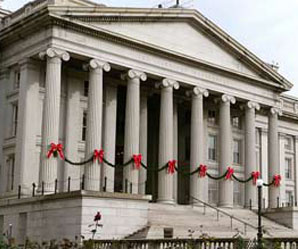One of the main watchdogs over the government’s $13 billion financial bailout, the Congressional Oversight Panel, released its monthly report for July today, bringing some much needed scrutiny to the repayment of TARP funds and the Treasury Department’s questionable oversight of that process. The COP highlighted the sale of government-held warrants (options to buy stock for a set price over a predetermined time period) back to bailout recipients exiting TARP, who, according to Treasury’s guidelines, get the first crack at repurchasing their own warrants. This repurchasing process began earlier this spring, when the first bailed-out banks bought their stocks and warrants to extricate themselves from the taxpayer-funded TARP; since then, the process has been dogged by numerous reports showing that the Treasury sold warrants for much less than they could have. By one estimate, taxpayers were shortchanged in those early transactions by millions of dollars.
The COP’s latest report puts a number to what many suspected: The Treasury, the panel estimates, sold warrants back to the 11 small banks who’ve so far completely exited the bailout for only 66 percent of their value. If the Treasury had sold them for closer to market value, taxpayers could’ve recouped $10 million more—a small sum compared to the entire bailout, but nothing to scoff at. And though the warrant-repurchasing process will differ for megabanks like JPMorgan Chase, Wells Fargo, and several others currently trying to buy back their warrants, applying that 66-percent rate to all government-held warrants could result in a loss of $2.7 billion.
If you’ve closely followed the COP’s reports, you’ll notice a troubling similarity to previous reports in this latest finding. The panel’s widely cited February report (PDF), which analyzed the Treasury’s 10 largest TARP investments in 2008, found that the Treasury had received, on average, only $66 for every $100 spent, resulting in a $78 billion shortfall. (This while Berkshire Hathaway received $110 assets for every $100 when it invested in Goldman Sachs, and Mitsubishi received $91 in assets for every $100 invested in Morgan Stanley.) Which means that the Treasury received a 34-percent markdown on assets it bought (with taxpayer money) last year with its early TARP investments, and received only a 34-percent markdown for its early warrant sales back to banks.
Coincidence? Hardly.
From the very outset of TARP, the Treasury has consistently failed to maximize taxpayers’ more than $1 trillion investment to rescue crumbling financial institutions—even though the Emergency Economic Stabilization Act of 2008 specifically said the financial rescue must “maximiz[e] overall returns to the taxpayers of the United States.”
That said, it’s not too late for the Treasury to change course and try to recoup more taxpayer funds through the warrant-repurchasing process. What the Treasury should do, as MIT’s Simon Johnson and other experts have pointed out, is sell the warrants in an open auction. That way the Treasury would likely receive a more fair price, one closer to market value, and banks trying to repurchase their own warrants could bid on them like every other interested party. An open auction would also inject a healthy dose of transparency into an otherwise opaque process, one in which trillions of taxpayer dollars have changed hands with little public acknowledgment by the government. Even then, when the dust has settled on the entire bailout, it will be taxpayers who end up as the biggest losers of all.














